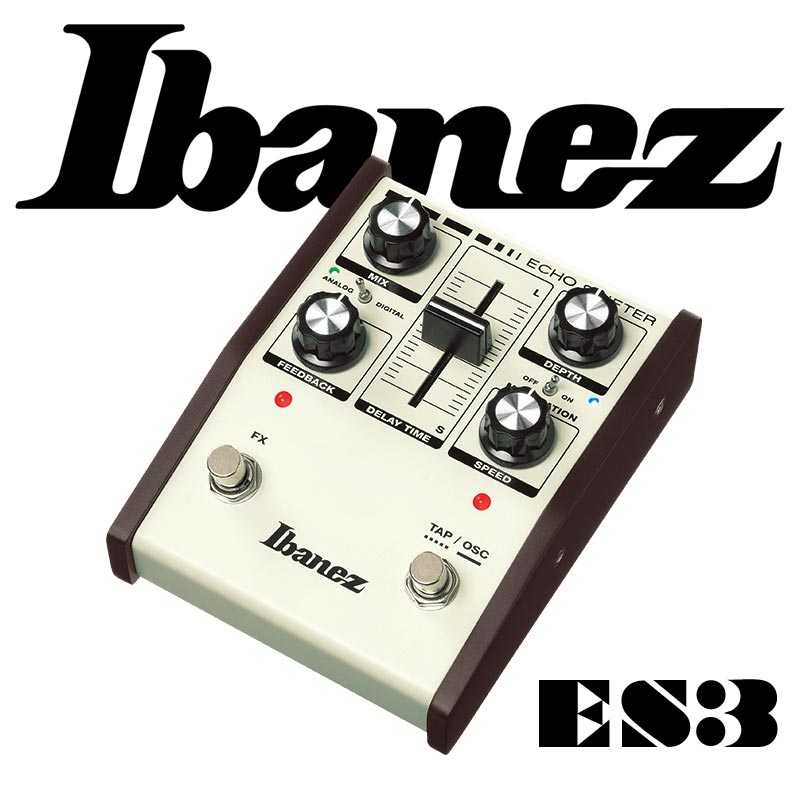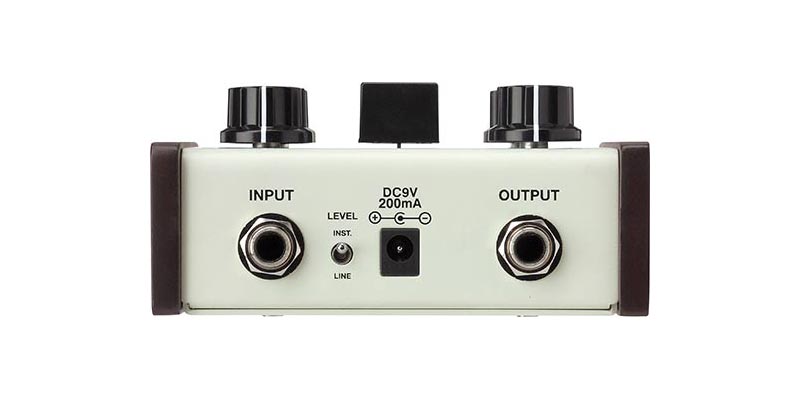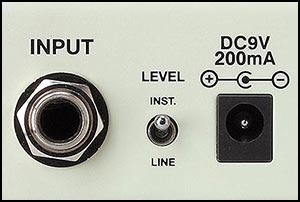The Ibanez ES3, the third incarnation of their Echo Shifter series, was announced at NAMM 2020 and finally came to market over the summer. We gave it a long-term test with four reviewers (their impressions in quotes below) and came away impressed on how the ES3 manages to retain a guitar or synthesizer’s tone during heavy processing, as well as the improvements over the previous version.

First and foremost, even though the ES3 is a guitar pedal, “it seems like it was designed more to be placed on a stand,” surmised one reviewer. The front face contains two toggles, two switches, four knobs, and one slider. While you may be able to “make adjustments to the settings if you have a very dexterous foot” most guitarists will be forced “to bend over more than they want” to dial in the sound they desire. This layout may be cumbersome to guitars, but to synthesists, who will have the ES3 next to their favorite module or or on top of their keyboard, it works quite well.
The Ibanez ES3 Echo Shifter is well constructed with smooth rotating knobs, positive toggles and two solid foot switches. The cream-colored unit is flanked by two faux-wood side panels for a retro, yet elegant look. The ES3 requires a dedicated 9V | 200mA power supply, but you’ll have to source your own PSU since its not included and cannot be powered by batteries. This was noted as a deficit to our keyboard player and ambient synthesist who remarked, “no power supply, and you can’t even buy an Ibanez one? I don’t get it.” Our guitarist didn’t even flinch since he already had a multi output power unit for his pedal board and simply plugged it into an empty slot.

The ES3’s interface has been reconfigured from the previous version based on feedback from users and technology advancements by Ibanez. Instead of a toggle for Oscillation, the EC3 adds that feature to the Tap button by simply holding it down. The new layout is logical and works well in use.
The left side of the front panel contains a rotary knob to determine the Mix between input signal and the effects, a Feedback rotary to dial in the amount of Feedback and a toggle to select an Analog Delay and a Digital Delay. The middle section contains a 45mm Slider to determine Delay Time: Analog from 40ms to 600ms and Digital from 40ms up to 1500ms. The right section contains the modulation potential with a rotary to dial in the Depth, an on/off modulation toggle and a rotary to determine the Speed. Below are two switch FX on/off plus the Tap/Osc for tempo sync and “death by oscillation,” jested one reviewer, by holding the switch down. On the rear we have power input, 1/4″ input, 1/4″ output and Level: Line or Instrument. Sadly, the ES3 is not stereo.

The easiest way for electronic musicians to get their music onto Spotify, Apple Music, iTunes, Amazon Music, Tidal, Instagram, Facebook, TikTok, Pandora, Twitch & much more! Click the banner above or the Go Button to save 7% off of your signup! GO!

Operation is quite straight forward and all of our evaluators were able to get up to speed quickly. There is quite a difference between the Digital and Analog delays, more than simply the delay time. The Analog Delay has a “more laidback vibe” with a “softer” and “smooth” signature, while the Digital delay is “more upfront” and “in your face,” as well as “louder and clearer.” Moving the Slider while processing has an immediate affect on the sound without any lag and can “bend the sound in pleasing ways.” Shorter delay times yield “a nice Chorus effect without harmonic blur” and then “adding just the right modulation can deliver a musical shimmer, which I quite liked,” noted our guitarist.
Our ambient synthesist immediately gravitated towards the modulation and enjoyed pressing the ES3 into self modulation by holding down the Tap/OSC switch. “I was able to create some great loops [by holding down the Tap/OSC switch] that I then recorded and reprocessed with some plug-ins. The only downside is that once you release the switch, the loop quickly drops out…instead of nodding off with a long tail.”
Ibanez ES3 Features:
- Controls: Mix, Feedback, Depth, Speed, Delay Time
- Switches: Effect on/off, Tap/Oscillation on (press and hold), Analog/Digital, Modulation On/Off, Inst/Line
- I/O’s: Input, Output is on the right side. Input is on the left side.
- Delay time: Analog 40ms – 600ms, Digital 40ms – 1500ms
- Size: 116mm (W) x 153mm (D) x 57mm (H)
- Size: 4.6″ (W) x 6.0″ (D) x 2.3″ (H)
- Required Current: 200mA | 9V
- Power Supply: External DC 9 volt AC adapter (Not Included)

Using the Tap/OSC for tempo also challenged the non guitarists. “Just a whole different feel than using the tap tempo on my drum machine. You can do it for slow to medium tempos, but anything above 110 BPM will be a comedy routine, or a new TikTok dance.” Our guitarist laughed this off as well saying “if Ibanez wanted precise tempo control there would have been a MIDI Input, for me, it works just fine.”
Where the Ibanez ES3 Echo Shifter was lauded across the board was its ability to retain the pure tone of the instrument all the way through the delay processing. “I can’t mention this enough,” emphasized our guitarist, “and how important it is, but the way the ES3 doesn’t bastardized the guitar tone when baking in the delay is amazing. Many pedals mangle the sound, or add so much color, that you lose the feel, and not in a good way.” Our keyboardist agreed, “definitely one of more musical delay pedals I’ve used. I love my Strymon, but it has a tendency to annihilate my patches.” Our ambient composer cited the tone as well, especially for musicians who chain their pedals. “The [ES3’s] ability to retain the structure and clarity of the original sound allows it to retain its integrity throughout my processing chain.”
Conclusion
If you want a high-quality delay pedal with some modulation tricks up its sleeve at half the price of some other notable pedals, the ES3 should definitely be on your demo list. Containing both analog and digital delay in one unit, the ES3 works well in many different applications, making it one of the more versatile delay units available today. Its ability to retain the integrity of the original tone, also bodes well for musicians “who are interested in a simple Delay solution” or looking to add the ES3 to their processing chain for more complex sonic explorations. Recommended.
Rating: 83%
Cheers:
+ Build Quality
+ Sound Quality
+ Versatility
+ Easy To Use
Jeers:
– No Power Supply
– Mono
– Tap Tempo
– OSC Release

The Ibanez ES3 Echo Shifter costs $199.99 and is available now.
The Future: We’d love to see Ibanez add a few features to the ES4. First and foremost, a stereo output would certainly be a welcome addition for even more depth, as long it maintains the purity of the original signal like the ES3. The ability to control the release of the delay would also make it more a touch more sophisticated in operation. USB connectivity, as well as MIDI implementation, would add a modern touch to the ES3 that competitors currently offer.






